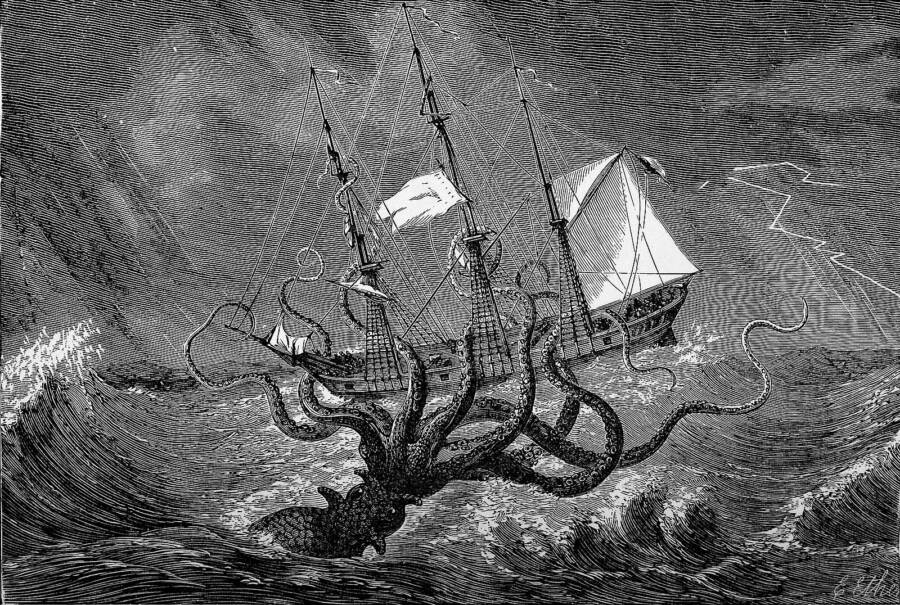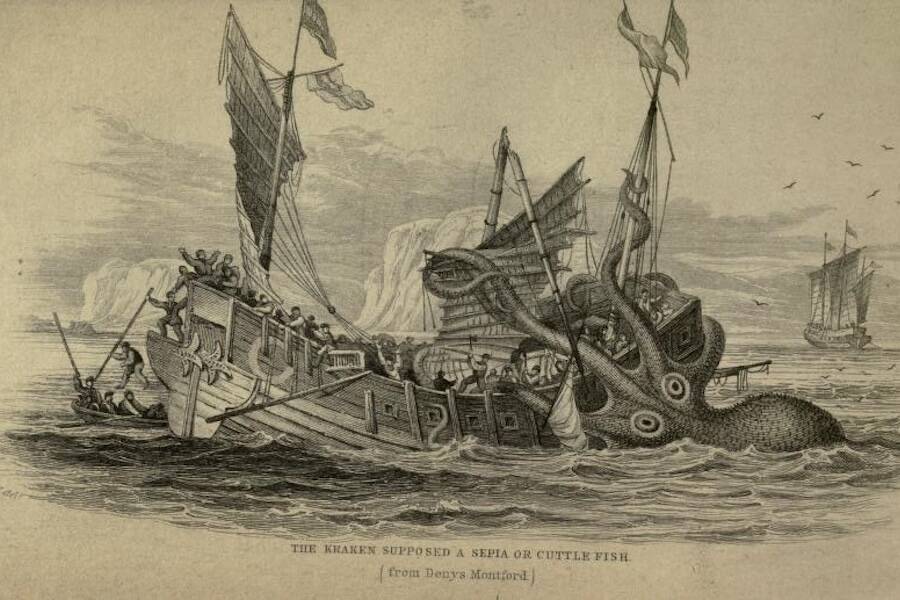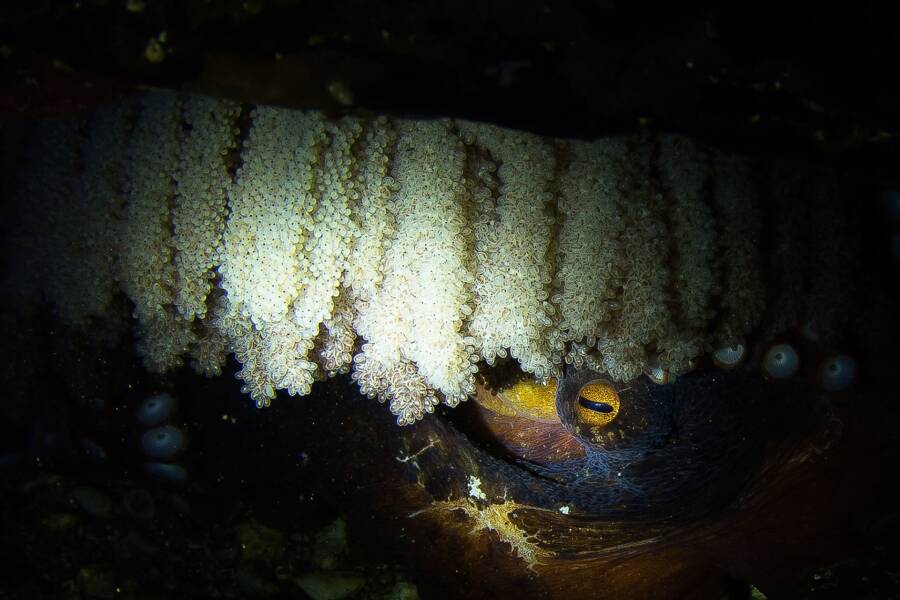A squid-like beast said to live in the sea between Norway and Iceland, the Kraken is one of the world's most legendary sea creatures.

Wikimedia CommonsAn 1887 illustration of the mythical Kraken.
Scandinavian folklore tells of countless legendary creatures, and one of the most famous is the Kraken. Said to be a squid-like monster capable of destroying entire ships, the Kraken may seem like pure fiction today. And yet, numerous sailors from centuries past claimed to have encountered it. So, what is a Kraken? Is it the product of the overactive imaginations of early seafarers, or a real animal that lurks in the sea?
Starting in the 13th century, mariners began reporting alleged sightings of the Kraken, claiming that they saw giant tentacles in the water that were powerful enough to crush or capsize their ships. Many of these purported sightings happened in the sea between Norway and Iceland. Later on, explorers and religious figures would publish more detailed accounts of what the Kraken looked like — and how it supposedly terrorized sailors.
One of the earliest detailed descriptions came from an 18th-century Danish bishop named Erik Pontoppidan, who described the sea monster in his book The Natural History of Norway. Incredibly, about a century later, Herman Melville’s famous novel Moby-Dick told of a giant squid that might be “the great Kraken of Bishop Pontoppidan.” The Kraken would later appear in Jules Verne’s novel Twenty Thousand Leagues Under the Seas, followed by several other books, poems, and later, television shows and movies.
But while the Kraken has had a long hold on pop culture, this fabled sea beast remains shrouded in mystery. Though some claim the creature is merely a legend, or a very large squid or octopus that hadn’t been identified yet centuries ago, others point to the long and intriguing history behind the monster — and claim that the Kraken might actually be real.
What Is A Kraken? The Origins Of The Myth

Wikimedia CommonsThe Kraken was said to pull ships into the depths of the ocean with its powerful tentacles.
Though the Kraken has long been a fixture in Scandinavian lore, one of the first descriptions of the beast in writing came from Francesco Negri. An Italian priest and travel writer, Negri described the creature in a travelogue at the turn of the 18th century after a lengthy exploration of Scandinavia.
In Negri’s text Viaggio settentrionale, he claimed that the Kraken was a multi-horned “fish” with many arms. Negri also distinguished the creature from the sea serpent, another legendary beast said to lurk in the waters.
The second notable account of the mythical creature came a few decades later from Hans Egede, a Dano-Norwegian missionary, who claimed that the Kraken was similar to another legendary animal known as the Hafgufa (which some modern-day scientists believe was actually a whale).
While these descriptions certainly painted a vivid picture of what the Kraken might look like, they paled in comparison to that of Danish bishop and historian Erik Pontoppidan. In his Natural History of Norway book, first published in 1752, he asserted that the Kraken is “round, flat, and full of arms, or branches.” He also said it measured a mile and a half across and that it was “the largest and most surprising of all the animal creation.”

Wikimedia CommonsAn illustration of the Kraken from Twenty Thousand Leagues Under the Sea by Jules Verne.
In addition, he cited several fishermen “who unanimously affirm, and without the least variation in their accounts,” that anyone rowing into the Norwegian Sea in the summer is in mortal danger due to the Kraken. Pontoppidan added that these fishermen warned that catching a lot of fish is a bad omen — as they only surfaced to escape the beast.
“Here and there a larger rising is observed like sand-banks, on which various kinds of small Fishes are seen continuously leaping about till they role [sic] off into the water from the sides of it; at last several bright points or horns appear, which grow thicker and thicker the higher they rise above the surface of the water,” Pontoppidan wrote of the Kraken’s terrifying appearance.
Pontoppidan also noted that these horns can “stand up as high and as large as the masts of middle-siz’d vessels.” Emerging from the depths with a purportedly “strong and peculiar scent,” the Kraken “opens his arms, or horns, seizes and swallows his welcome guests, and converts them, after the due time, by digestion, into a bait for other Fish of the same kind.”
Why The Kraken Myth Is So Terrifying
If these original accounts are to be believed, the Kraken uses its stench and secretions to attract fish in the sea that it can prey upon. But while it would be happy with a diet of only fish, it has the ability to target humans as well.
As legend tells it, the Kraken’s tentacles can easily rise above the surface of the water and latch onto a ship. If the creature so desires, it can destroy the entire vessel, dragging the unlucky sailors aboard to their doom.
Many early seafarers who claimed to have survived an encounter with the Kraken stated that the creature was capable of creating such a powerful suction vortex that any men unable to swim away from it would be sucked into the deep and drown. These horrifying tales then spread far and wide.
Even more unsettling, some early descriptions alleged that the Kraken could have multiple heads instead of just one — and “a number of claws” capable of capturing any prey the creature desired, including unfortunate seamen.

Wikimedia CommonsSome believe that anxious seamen mistook large squids or octopuses for the Kraken.
Strangely enough, some fishermen claimed that they mounted the beast and figured out a way to send it back into the depths of the ocean — simply by pronouncing its name. However, most seafarers feared the monster and tried to avoid the areas where it had allegedly been spotted at all costs.
But were sailors really afraid of the sea monster itself — or simply the possibility that a creature like that existed at all?
In modern times, some experts have noted that the isolation early seafarers experienced during their voyages could lead to serious psychological effects. Thus, the Kraken might speak more to man’s fear of the unknown rather than a giant, squid-like creature that supposedly swam below them.
And in a world before modern-day science, the fear of the unknown could be particularly paralyzing to some of the early explorers of the ocean.
Modern-Day Experts Weigh In On The Legend

Wikimedia CommonsA giant Pacific octopus (or Enteroctopus dofleini) spawning.
While some researchers firmly believe that the Kraken myth emerged due to early sailors’ overactive imaginations during their voyages, others are confident that the cryptid was inspired by shadowy sightings of real sea creatures, namely giant squids and large octopuses.
Giant squids in particular can reach staggering sizes, after all, and often measure dozens of feet in length. They’re also rather elusive, making these encounters all the more shocking for anxious sailors of the past.
For Jon Ablett, the Senior Curator of Mollusca at London’s Natural History Museum, the Kraken was likely a mere amalgamation of “partially digested or rotted remains of giant squid and large octopus” that washed up on beaches, leading people to speculate about what these creatures might be.
“Squid and octopus really are unusual animals,” explained Ablett. “Their body plan isn’t similar to anything else that we know of in the sea. They move quickly and the way that their bodies, arms and tentacles move seem to stimulate something in our fear of the unknown.”
“I think the fact that they are such odd creatures, with some very large species being very rarely seen, make it very likely that they could be the starting points for the Kraken and other sea beast legends,” he continued. “In Norway, the Kraken myth grew and such washed-up specimens were interpreted as messages from God or the Devil, sometimes called sea angels, sea devils, or sea monks. These things happened separately and people around the world came up with similar answers and mythologies.”

Metro-Goldwyn-MayerThe Kraken myth has likely endured because of its long hold on pop culture, including its famous appearance in the 1981 film Clash of the Titans, which introduced the iconic catchphrase “Release the Kraken!”
Ablett called this phenomenon “a case of convergent evolution in myth form,” as more than one nation or group of people developed this legend at the same time. Perhaps the Kraken has remained so legendary because it’s been mentioned in so many modern books, movies, and television shows.
For Edie Widder, an ocean researcher who captured rare footage of a giant squid, there are nonetheless valid reasons for this myth to be so prevalent.
“The reason we know giant squids exist is that they happen to float when they die,” Widder said in an interview with NPR. “But we really [have] only explored 5 percent of the ocean, and I think we’ve explored that in the wrong way. I think we’ve scared a lot of animals away. So what about the stuff that doesn’t float when it dies?”
While much of the ocean indeed remains unexplored, many modern people doubt that the Kraken ever existed. And even some who do believe in the legend think that the earliest accounts of it were exaggerated. However, others remain convinced that the creature lurks in the deep to this day. For Widder, finding a giant squid in the vastness of the ocean was stunning enough — as this was an elusive creature one could actually photograph.
“It’s just amazing to be able to have a moment like that and realize you’ve done something people have been trying to do for decades,” Widder told NPR. “That’s what got me into science in the first place — this opportunity to explore a new frontier.” Only time will tell what other fascinating animals will be discovered in the depths of the ocean in the years to come.
After learning about the Kraken, check out the definitive list of history’s creepiest cryptids. Then, discover the 33 scariest real animals in the world.






